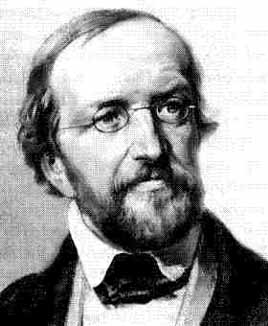Next: Examples with Sage Up: Dirichlet's Unit Theorem Previous: Dirichlet's Unit Theorem Contents
We prove the theorem by defining a map
![]() , and
showing that the kernel of
, and
showing that the kernel of ![]() is finite and the image of
is finite and the image of ![]() is a lattice in a hyperplane in
is a lattice in a hyperplane in
![]() . The trickiest part of the
proof is showing that the image of
. The trickiest part of the
proof is showing that the image of ![]() spans a hyperplane, and we
do this by a clever application of Blichfeld's Lemma 7.1.5.
spans a hyperplane, and we
do this by a clever application of Blichfeld's Lemma 7.1.5.

He is a rather tall, lanky-looking man, with moustache and beard about to turn grey with a somewhat harsh voice and rather deaf. He was unwashed, with his cup of coffee and cigar. One of his failings is forgetting time, he pulls his watch out, finds it past three, and runs out without even finishing the sentence.Koch wrote that:
... important parts of mathematics were influenced by Dirichlet. His proofs characteristically started with surprisingly simple observations, followed by extremely sharp analysis of the remaining problem.I think Koch's observation nicely describes the proof we will give of Theorem 8.1.2.
Units have a simple characterization in terms of their norm.
Let ![]() be the number of real and
be the number of real and ![]() the number of complex conjugate
embeddings of
the number of complex conjugate
embeddings of ![]() into
into
![]() , so
, so
![]() .
Define the log embedding
.
Define the log embedding
To prove Theorem 8.1.2, it suffices to prove that
Im![]() is a lattice in the hyperplane
is a lattice in the hyperplane ![]() of
(8.1.1), which we view as a vector space of dimension
of
(8.1.1), which we view as a vector space of dimension
![]() .
.
Define an embedding
| Re |
We will use the following lemma in our proof of Theorem 8.1.2.
 |
||
Thus suppose
![]() .
Define a function
.
Define a function
![]() by
by
Let


Recall Blichfeldt's Lemma 7.1.5, which asserts
that if ![]() is a lattice and
is a lattice and ![]() is closed,
bounded, etc., and has volume at least
is closed,
bounded, etc., and has volume at least
![]() , then
, then
![]() contains a nonzero element. To apply this lemma, we
take
contains a nonzero element. To apply this lemma, we
take
![]() , where
, where ![]() is as in (8.1.2).
By Lemma 7.1.7,
we have
is as in (8.1.2).
By Lemma 7.1.7,
we have
![]() . To check the hypothesis
of Blichfeld's lemma, note that
. To check the hypothesis
of Blichfeld's lemma, note that
 |
||
 |
||

Recall that our overall strategy is to use an appropriately chosen ![]() to construct a unit
to construct a unit ![]() such
such
![]() . First, let
. First, let
![]() be representative generators for the finitely many
nonzero principal ideals of
be representative generators for the finitely many
nonzero principal ideals of ![]() of norm at most
of norm at most ![]() . Since
. Since
![]() , we have
, we have ![]() , for some
, for some ![]() , so there
is a unit
, so there
is a unit ![]() such that
such that ![]() .
.
Let

 |
Let
![]() , and note that
, and note that ![]() does not depend on the choice
of the
does not depend on the choice
of the ![]() ; in fact, it only depends on the field
; in fact, it only depends on the field ![]() .
Moreover, for any choice of the
.
Moreover, for any choice of the ![]() as above, we have
as above, we have
If ![]() , then we are trying to prove that
, then we are trying to prove that
![]() is a lattice
in
is a lattice
in
![]() , which is automatically true, so assume
, which is automatically true, so assume ![]() .
To finish the proof, we explain how to use Lemma 8.1.9
to choose
.
To finish the proof, we explain how to use Lemma 8.1.9
to choose ![]() such that
such that ![]() . We have
. We have
 |
||
William Stein 2012-09-24